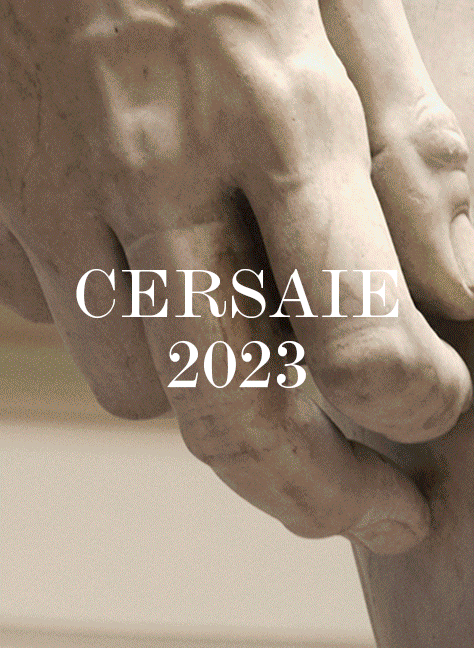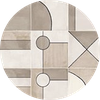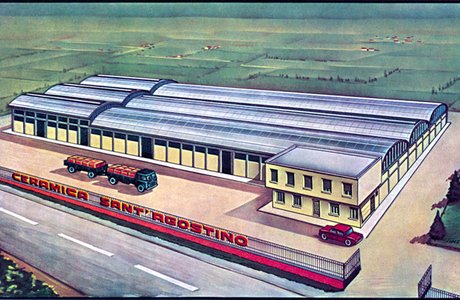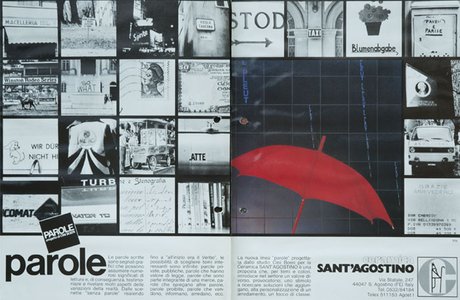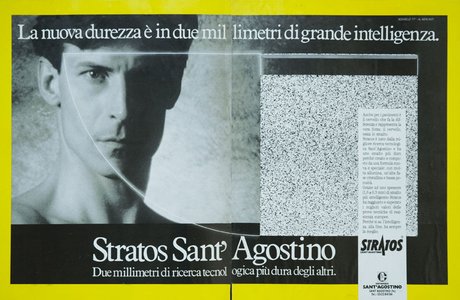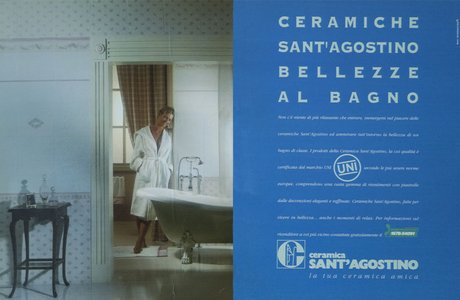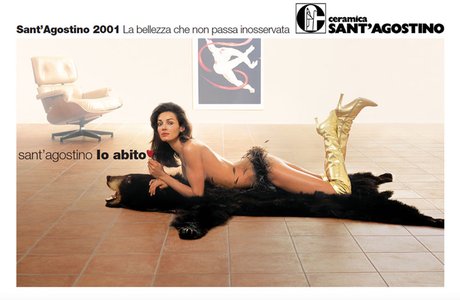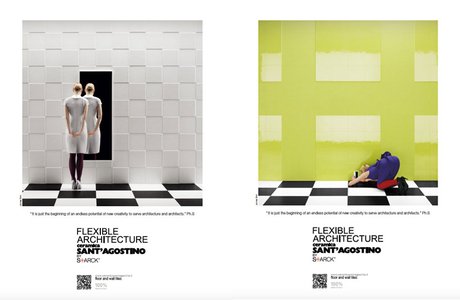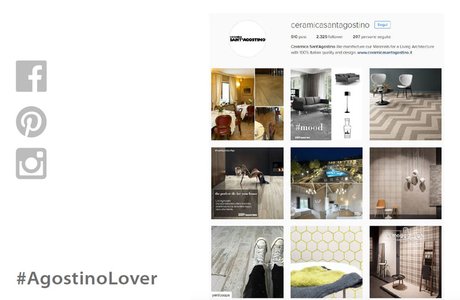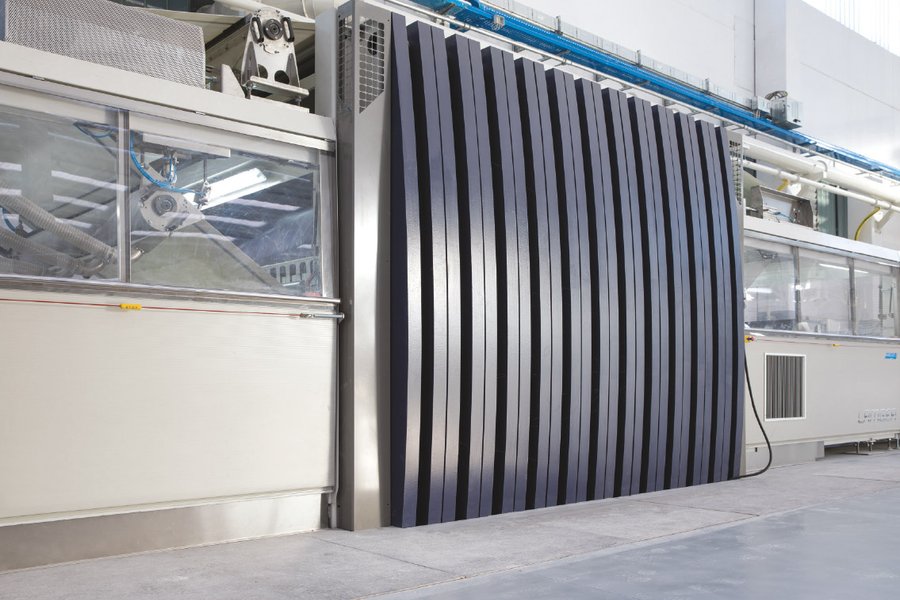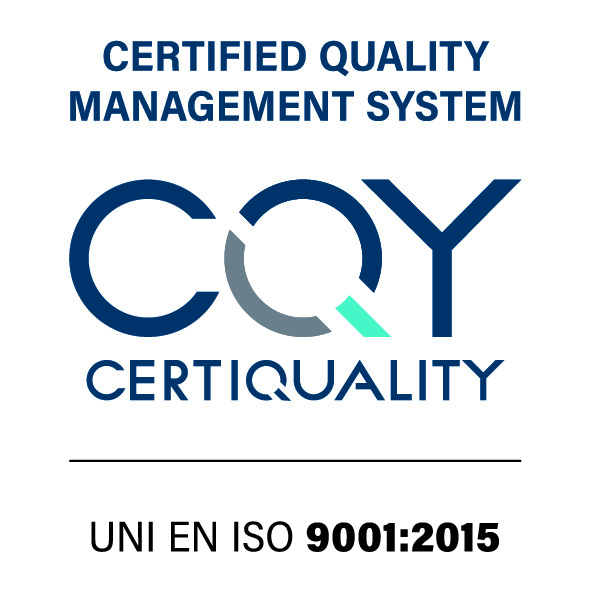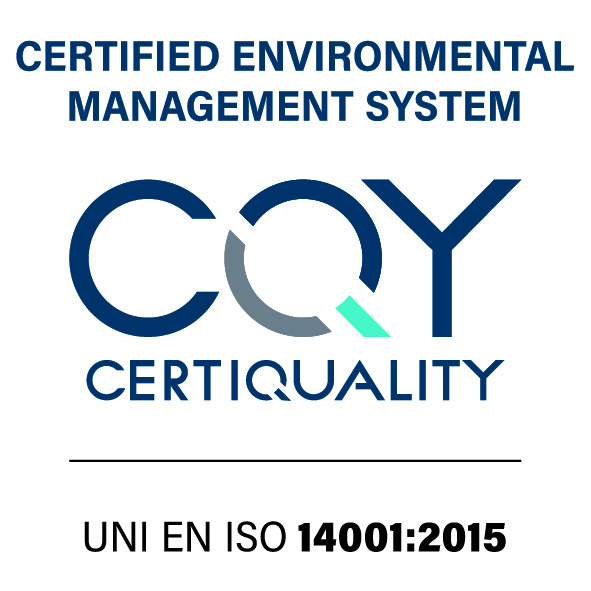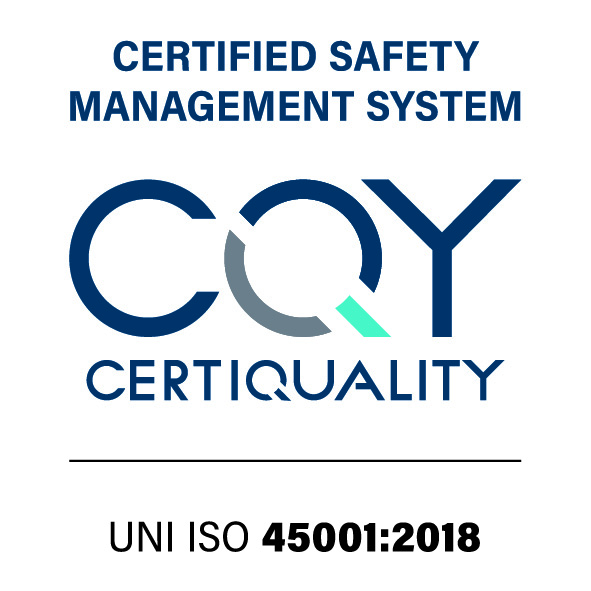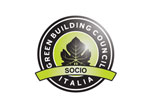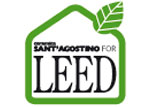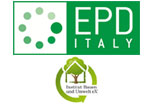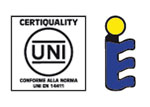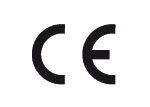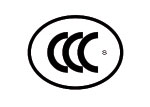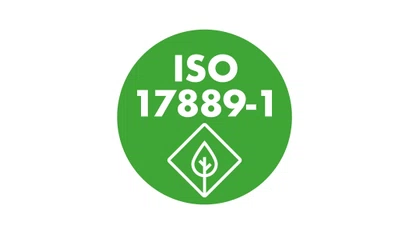ECOQUALITY
AN AMBITIOUS PROJECT OF ADVANCED TECHNOLOGY, ETHICS AND SUSTAINABILITY
ECOQUALITY is a complete action programme carried out by Ceramica Sant’Agostino to coordinate all the company’s efforts aimed to obtaining very high quality products while totally respecting the strict European and international rules to protect the environment, the persons and the end-users. ECOQUALITY is a process that involves the whole company organization and therefore ambitious, objectively measurable and continually evolving.

1.100.000 KWH
Autonomous production of clean energyWe have built a cutting-edge photovoltaic system to autonomously produce electricity from the sun. The system produces 1,100,000 KWh/year, which means 507 tonnes of CO2 not released into the atmosphere every year. The commitment of Ceramica Sant’Agostino to increase the use of alternative energies has become an important, concrete project.

271.380.000 M2
Contributing to preserving the ecosystemThe company is engaged in a project, certified by the Plan Vivo Foundation, in Meghalaya (north eastern state of India), which covers an area of 271.380.000 m2. The project contributes to the restoration and preservation of the ecosystem of this state of India. The goal is twofold: to neutralize CO2 emissions and to develop local communities by involving them operationally.
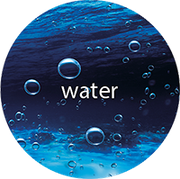
3.600 M3
Integrated water management systemOur company uses a rainwater recovery system which offers more than 10% savings on mains water consumption. We discharge no water into the surrounding environment: the processing water is completely recycled and reused in the production processes. All this translates into water savings of approx. 3.600 m3 per year.
OUR MANAGEMENT SYSTEM CERTIFICATES

UNI EN ISO 9001
Ceramica Sant’Agostino S.P.A. has adopted a Quality Management System since 2008 to improve the control of its products and services in compliance with the current regulations and internal specifications in order to meet the needs and expectations of its customers and all the parties concerned.
This is carried out by pursuing the following objectives:
• Guarantee customer support and assistance.
• Value its own human resources.
• Obtain continuous process improvement.
• Schedule the control of plants, tools and equipment in order to ensure their correct use, maintain high efficiency and reliability of the measurements and of the product test.
• Create a relationship of mutual benefit between suppliers and subcontractors in order to achieve common business results.
• Improve business management processes on an ongoing basis.
• Contribute to the improvement of the social context of which Ceramica Sant’Agostino is a part, respecting and valuing the people and the environment in which it is integrated.

UNI EN ISO 14001:2015
Ceramica Sant’Agostino S.P.A. has adopted an Environmental Management System since 2017. Its application allows a systematic and documented approach to environmental aspects aimed at protecting the environment and, pursuing the continuous improvement of performance, to be able to respond to the change in environmental conditions in balance with the needs of the socio-economic context in compliance with legislative obligations.
Therefore, among the objectives:
• protect the environment by preventing or mitigating negative environmental impacts
• mitigate the potential negative effect of environmental conditions on the organization
• support the organization in fulfilling its legislative compliance obligations
• improve environmental performance and the consumption of natural resources
• provide guidance for the design, production, distribution, use and disposal of products using a life cycle perspective in order to avoid unwanted or avoidable environmental impacts at any stage.

UNI ISO 45001:2018
Ceramica Sant’Agostino S.P.A. has adopted an Occupational Health and Safety Management System since 2014. Its application allows a systemic approach to the management of occupational safety and health protection, leading to risk minimization, continuous improvement in addition and compliance with legislative requirements.
Therefore, among the objectives:
• implement a constantly evolving management system that takes into account the technological and regulatory development, etc. with a tendency to minimize the risks to personnel and all the parties concerned that could be exposed to the health and safety hazards associated with its activities, while maintaining and continuously improving the OHSMS.
• identify the dangers, assess the risks and identify control methods, in close connection with the legislative or other prescriptions adopted according to specific targets;
• train, educate and involve the staff and their representatives;
• establish and maintain adequate measures to identify, prevent and control possible accidental events (injuries and near misses) and emergencies;
• monitor and measure the performance of the safety and health system, as well as the maintenance of legislative compliance.
OUR PRODUCTS CERTIFICATES

GBC
Ceramica Sant’Agostino è membro del Green Building Council Italia (GBC) l’ente che ha il compito di redigere il regolamento LEED Italia, ovvero l’insieme di norme in accordo con lo standard internazionale LEED pensate per promuovere la realizzazione di edifici che tutelano l’ambiente e la salute delle persone che ci vivono. Associandosi al GBC Italia, Ceramica Sant’Agostino si propone di contribuire alle attività di introduzione del sistema di certificazione LEED nel nostro paese.

LEED
LEED credits give all the operators in the field the necessary instruments to objectively calculate the building impact in terms of environmental sustainability. The system is based on a credit rating for each requirement regarding a building eco-compatibility. The credit sum determines the certification level achieved, which also contributes to increase the building competitive level on the real estate market. CSA products give a very good performance on the requirements of LEED certifications. Our production uses a percentage of recycled material above 20% (pre-consumer material). No toxic substance is released, no contribution to heath island effect is caused, and production is carried out in factories with environmental management system.
LEED CREDITS OBTAINABLE THROUGH USE OF CERAMICA SANT’AGOSTINO PRODUCTS
LEED NC (New Constructions) (Analysis based on Leed 2009 USGBC rules )
| SS Credit 7.1 | Heat Island Effect – Nonroof Heat Island Reduction |
1 point |
| SS Credit 7.2 | Heat Island Effect – Roof Optimize Energy Performance |
1 point |
| MR Credit 1.2 | Building Reuse 50% Interior | 1 point |
| MR Credit 2.1 | Construction Waste Management 50% | 1 point |
| MR Credit 2.2 | Contruction Waste Management 75% | 1 point |
| MR Credit 4.1 | Recycled Content 10% | 1 point |
| MR Credit 4.2 | Recycled Content 20% | 1 point |
| MR Credit 5.1 | Regional Materials 10% | 1 point |
| MR Credit 5.2 | Regional Material 20% | 1 point |
| EA Prereq 2 | Minimum Energy Performance | |
| EA Credit 1 | Optimize Energy Performance | 1-19 points |
| EQ Credit 4.1 | Low Emitting Materials – Adesive & Sealants | 1 point |
| EQ Credit 4.2 | Low Emitting Materials – Flooring Systems | 1 point |
| ID Credits | Innovation in Design | 1-5 points |
LEED CI (Commercial Interiors) (Analysis based on Leed 2009 USGBC rules)
| MR Credit 1.2a | Building Reuse 40% | 1 point |
| MR Credit 1.2b | Building Reuse 60% | 1 point |
| MR Credit 4.1 | Recycled Content 10% | 1 point |
| MR Credit 4.2 | Recycled Content 20% | 1 point |
| MR Credit 5.1 | Regional Materials 10% | 1 point |
| MR Credit 5.2 | Regional Material 20% | 1 point |
| EQ Credit 4.1 | Low Emitting Materials – Adesive & Sealants | 1 point |
| EQ Credit 4.2 | Low Emitting Materials – Flooring Systems | 1 point |
| ID Credits | Innovation in Design | 1-5 points |
LEED EB (Existing Buildings) (Analysis based on Leed 2009 USGBC rules)
| SS Credit 7.1 | Heat Island Effect - Nonroof | 1 point |
| SS Credit 7.2 | Heat Island Effect - Roof | 1 point |
Further information on the LEED system
LEED NC (New Constructions) (Analysis based on Leed 2009 USGBC rules)
SS Credit 7.1: Heat Island Effect – Nonroof (1 point) Same contribution also for LEED EB
Intent
To reduce the heat island effect (thermal gradient differences between developed and underdeveloped areas) to minimize impacts on microclimates and human and wildlife habitats.
Requirements
Option 1
Use any combinations of the following strategies for 50% of the site hardscape (included roads, sidewalks, courtyards and parking lots)
- Shade (within 5 years from installation)
- Flooring materials with solar reflectance index (SRI) of at least 29
- Open-grid pavement systems
Or
Option 2
Place a minimum of 50% parking spaces under cover (defined as ground, under deck, under roof of under building). Every roof used to shade or cover parking lots must have a SRI of at least 29.
The contribution of Ceramica Sant’Agostino products
The Certifications proving the solar reflectance index of the product chosen is available on request.
SS Credit 7.2: Heat Island Effect – Roof (1 point) Same contribution also for LEED EB
Intent
To reduce the heat island effect (thermal gradient differences between developed and underdeveloped areas) to minimize impacts on microclimates and human and wildlife habitats.
Requirements
Option 1
Use roofing materials with SRI equal to or greater than the values in the table below for a minimum of 75#37; of the roof surface.
| ROOF TYPE | SLOPE | SRI |
| LOW-SLOPED ROOF | <=2:12 | 78 |
| HIGH-SLOPED ROOF | >2:12 | 29 |
Or
Option 2
Install a vegetated roof that covers at least 50% of the roof area.
Or
Option 3
Install high solar reflectance surfaces or vegetated roofs that, in combination, meet the following criteria: (Area roof meeting minimum SRI/0.75) + (Area of vegetated roof /0.5) ≥ Total Roof Area.
The contribution of Ceramica Sant’Agostino products
The Certifications proving the solar reflectance index of the product chosen is available on request.
MR Credit 1.2: Building Reuse 50% Interior (1 point)
Intent
To extend the lifecycle of existing building stock, conserve resources and existing architectural style, reduce waste and environmental impacts on new buildings as they relate to materials manufacturing and transport.
Requirements
Use existing interior nonstructural elements (e.g. interior walls, doors, floor coverings and ceiling system) in at least 50% (by area) of completed building, including addictions. If the project includes an addiction with square footage more than 2 times the square footage of the existing building, this credit is not applicable.
The contribution of Ceramica Sant’Agostino products
Ceramica Sant’Agostino tiles can contribute to the credit when used to cover existing floors and walls. You can thus renovate surfaces and structures in a simple an ecological way and save expensive building works. Moreover the flexibility and design of Ceramica Sant’Agostino tiles besides preserving and increase the lifecycle of existing areas where they are laid, contribute to enhance the building value thanks to their unquestionable stylistic and technical value.
MR Credit 2.1: Construction Waste Management 50% (1 point)
Intent
To avoid that construction and demolition debris are taken to landfills and incineration facilities. Redirect recyclable recovered resources back to the manufacturing process and take reusable material to appropriate waste collection sites.
Requirements
Recycle and/or salvage at least 50% of nonhazardous construction and demolition debris. Develop and implement a construction waste management plan that identifies the materials not to be diverted from disposal and that determines whether the materials will be sorted on-site or co-mingled. Calculation can be done by weight or volume, but must be consistent throughout.
The contribution of Ceramica Sant’Agostino products
Ceramica Sant’Agostino products can be considered reusable materials, in fact in case of demolition the tiles can be used as inert material for foundations, as fill materials, embankments. In this way Ceramica Sant’Agostino products can be wholly reused, thus contributing to reach the LEED credit.
MR Credit 2.2: Contruction Waste Management 75% (1 point)
Intent
Avoid that construction, demolition and soil cleaning waste are thrown into landfills or incinerators. Reintroduce recyclable materials in the production cycle again and take reusable materials to waste collection disposal sites.
Requirements
Recycle and/or salvage at least 50% of nonhazardous construction and demolition debris. Develop and implement a construction waste management plan that identifies the materials not to be diverted from disposal and whether the materials will be sorted on-site or co-mingled. Excavation soil and yard waste form soil cleaning do not contribute to this credit. Calculation can be done by weight or volume, but must be consistent throughout.
The contribution of Ceramica Sant’Agostino products
Ceramica Sant’Agostino products can be considered reusable materials, in fact in case of demolition the tiles can be used as inert material for foundations, as fill materials, embankments. In this way Ceramica Sant’Agostino products can be wholly reused, thus contributing to reach the LEED credit.
MR Credit 4.1: Recycled Content 10% (1 point) Same contribution also for LEED CI
Intent
To increase the demand for building products that incorporate recycled materials, thereby reducing impacts resulting from extraction and processing of virgin materials.
Requirements
Use materials with recycled content such that the sum of postconsumer recycled content plus 1/2 of preconsumer content constitutes at least 10#37; (based on cost) of the total value of the materials in the project. The recycled content value of a material assembly is determined by weight. The recycled fraction assembly is then multiplied by the cost of assembly to determine the recycled content value.
The contribution of Ceramica Sant’Agostino products
Ceramica Sant’Agostino products have a certified precomsumer content of recycled material above 20#37;, therefore they can contribute to obtain the percentage required by the credit.
MR Credit 4.2: Recycled Content 20% (1 point) Same contribution also for LEED CI
Intent
To increase the demand for building products that incorporate recycled materials, thereby reducing impacts resulting from extraction and processing of virgin materials.
Requirements
Use materials with recycled content such that the sum of postconsumer recycled content plus 1/2 of preconsumer content constitutes at least 20#37; (based on cost) of the total value of the materials in the project. The recycled content value of a material assmbley is determined by weight. The recycled fraction assembly is then multiplied by the cost of assembly to determine the recycled content value.
The contribution of Ceramica Sant’Agostino products
Ceramica Sant’Agostino floor tiles (wall tiles do not contribute to the score in this credit) have a certified preconsumer content of recycled material above 20%, therefore they can contribute to obtain the percentage required by the credit.
MR Credit 5.1: Regional Materials 10% (1 point) Same contribution also for LEED CI
Intent
To increase demand for building materials and products that are extracted and manufactured within the region, thereby supporting the use of indigenous resources, and reducing the environmental impacts resulting from transportation.
Requirements
Use building materials or products that have been extracted, harvested or recovered, as well as manufactured, within 500 miles (804,5 km) of the project site for a minimum of 10#37; (based on the cost) of the total materials value. If only a fraction of a product or material is extracted, harvested, or recovered and manufactured locally, then only that percentage (by weight) can contribute to the regional value.
The contribution of Ceramica Sant’Agostino products
Ceramica Sant’Agostino floor tiles (wall tiles do not contribute to the score in this credit) are made with 50% materials deriving from European mines, so they contribute by 50% of their economic value to reach the score required for this credit.
MR Credit 5.2: Regional Material 20% (1 point) Same contribution also for LEED CI
Intent
To increase demand for building materials and products that are extracted and manufactured within the region, thereby supporting the use of indigenous resources, and reducing the environmental impacts resulting from transportation.
Requirements
Use building materials or products that have been extracted, harvested or recovered, as well as manufactured, within 500 miles (804,5 km) of the project site for a minimum of 10#37; (based on the cost) of the total materials value. If only a fraction of a product or material is extracted, harvested, or recovered and manufactured locally, then only that percentage (by weight) can contribute to the regional value.
The contribution of Ceramica Sant’Agostino products
Ceramica Sant’Agostino floor tiles (wall tiles do not contribute to the score in this credit) are made with 50% materials deriving from European mines, so they contribute by 50% of their economic value to reach the score required for this credit.
EA Prereq 2: Minimum Energy Performance
Intent
To establish the minimum level of energy efficiency for the proposed building and systems.
Requirements
The building project must comply with:
- the “mandatory provisions” (Sections 5.4, 6.4, 7.4, 8.4, 9.4, 10.4) in Standard ASHRAE/IESNA 90.1-2004 ;
- the “Prescriptive Requirements” (Sections 5.5, 6.5, 7.5 and 9.5) or the “performance requirements” (Section 11) in Standard ASHRAE/IESNA 90.1-2004;
The contribution of Ceramica Sant’Agostino products
Ceramica Sant’Agostino tiles are low thermal conductivity materials. From the data reported in the literature you can deduct the following reference values:
0,6 - 0,7 Wm-1 K-1, for tiles with porous structure (water absorption higher than 6#37;) [double fired]
1,0 - 1,3 Wm-1 K-1, for tiles with compact structure (water absorption lower than 1#37;) [porcelain]
Since these are low thermal conductivity materials, Ceramica Sant’Agostino tiles have insulating power, therefore they contribute to energy saving of the building.
EA Credit 1: Optimize Energy Performance (1-19 points)
Intent
To achieve increasing levels of energy performance beyond the prerequisite standard to reduce environmental and economic impacts associated with excessive energy use.
Requirements
Demonstrate a percentage improvement in the proposed building performance rating compared with the baseline building performance rating, through a simulation model of the whole building using the Building Performance Rating Method, reported in Appendix G of the rule ASHRAE/IESNA 90.1-2004. The points are attributed according to energy saved for the global building working (energy simulation).
The contribution of Ceramica Sant’Agostino products
Ceramica Sant’Agostino tiles are low thermal conductivity materials. From the data reported in the literature you can deduct the following reference values:
0,6 - 0,7 Wm-1 K-1, for tiles with porous structure (water absorption higher than 6#37;) [double fired]
1,0 - 1,3 Wm-1 K-1, for tiles with compact structure (water absorption lower than 1#37;) [porcelain]
Since these are low thermal conductivity materials, Ceramica Sant’Agostino tiles have insulating power, therefore they contribute to energy saving of the building.
EQ Credit 4.1: Low Emitting Materials – Adesive & Sealants (1 point) Same contribution also for LEED CI
Intent
To reduce the quantity of indoor air contaminants that are odorous, irritating and/or harmful to the comfort and well-being of installers and occupants.
Requirements
All adhesives and sealants used in the building interior and applied on-site must meet the requirements of the following reference standards:
- Adhesives, Sealants and primer Sealants: South Coast Air Quality Management District (SCAQMD) Rule #1168.
The contribution of Ceramica Sant’Agostino products
Ceramica Sant’Agostino product do not have any VOC (volatile organic compound). Besides they can be laid with low VOC content adhesives as indicated on the general catalogue and the section LAYING AND MAINTENANCE
EQ Credit 4.2: Low Emitting Materials – Flooring Systems (1 point) Same contribution also for LEED CI
Intent
To reduce the quantity of indoor air contaminants that are odorous, irritating and/or harmful to the comfort and well-being of installers and occupants.
Requirements
Paints and coatings used on the interior of the building and applied on-site must comply with the following criteria:
- Paints, coatings and primers must meet the Green Seal Standard GS-11, Paints. First Edition, May 20th, 1993.
- Anti-corrosive and anti-rust paints applied to interior ferrous metal substrates must meet the Green Seal Standard GC-03, Anti-corrosive Paints, second Edition, Januaru 7th, 1997.
- Clear wood finishes, floor coatings, stains, primers and shellacs must meet the South Coast Air Quality Management District (SCAQMD), Rule 1113, Architectural Coating, rules in effect on January 1st, 2004.
The contribution of Ceramica Sant’Agostino products
Ceramica Sant’Agostino product do not have any VOC (volatile organic compound). Download the certification by Centro Ceramico on all our products.
ID Credits: Innovation in Design (1-5 points) Same contribution also for LEED CI
Intent
To provide design teams and architects with the opportunity to achieve exceptional performance above the requirements set by the LEED Green Building Rating System and/or innovative performance in Green Building categories not specifically addressed by the LEED Green Building Rating System.
Requirements
Option 1
Demonstrate that one or more parameter proving the achievement of one or more LEED point has been widely exceeded if not doubled.
Option 2
Demonstrate that the use of construction technologies, spending strategies and technologically innovative products allow to increase the environmental performance of the project.
The contribution of Ceramica Sant’Agostino products
Most Ceramica Sant’Agostino products have one or more certification of Ecological product fit for green housing, like ANAB or ECOLABEL. These certifications, guaranteed by an external board, attest the unquestionable green vocation of the products and their contribution to increasing the project ecological performance.
LEED CI (Commercial Interiors) (Analysis based on Leed 2009 USGBC rules)
MR Credit 1.2a: Building Reuse 40% (1 point)
Intent
To extend the lifecycle of existing building stock, conserve resources and existing architectural style, reduce waste and environmental impacts on new buildings as they relate to materials manufacturing and transport.
Requirements
Use existing interior nonstructural elements (interior walls, doors, floor coverings and ceiling systems) in at least 40#37; (by area) of the completed building, including addictions.
The contribution of Ceramica Sant’Agostino products
Ceramica Sant’Agostino tiles can contribute to the credit when used to cover existing floors and walls. You can thus renovate surfaces and structures in a simple an ecological way and save expensive building works. Moreover the flexibility and design of Ceramica Sant’Agostino tiles besides preserving and increase the lifecycle of existing areas where they are laid, contribute to enhance the building value thanks to their unquestionable stylistic and technical value.
MR Credit 1.2b: Building Reuse 60% (1 point)
Intent
To extend the lifecycle of existing building stock, conserve resources and existing architectural style, reduce waste and environmental impacts on new buildings as they relate to materials manufacturing and transport.
Requirements
Use existing interior nonstructural elements (interior walls, doors, floor coverings and ceiling systems) in at least 60#37; (by area) of the completed building, including addictions.
The contribution of Ceramica Sant’Agostino products
Ceramica Sant’Agostino tiles can contribute to the credit by using them to cover existing floors and walls, thus renewing surfaces and structures in a simple and ecological way while avoiding expensive building works. Furthermore the versatility and design of Ceramica Sant’Agostino tiles, besides preserving and increasing the lifecycle of the existing areas, contribute to enhance the value of the building thanks to their unquestionable stylistic and technical prestige.
For further information www.usgbc.org

ENVIRONMENTILE
Environmentile is the new voluntary environment label with which Ceramica Sant’Agostino, according to rule ISO 14021, declares that Ceramica Sant’Agostino products are made with the lowest environmental impact obtainable with the most updated technological knowledge (BAT - best available techniques).
This approach demands rigorous, ongoing research that seeks to optimise the energy demands of production and the constant monitoring of every substance.
Our goal is to create products that are as safe as they are attractive; our commitment is to achieve this goal in the most eco-friendly possible way.
The key points of our Environmentile labels are:
- reducing the energy consumed in production;
- reducing the pollution of air and water;
- correct management procedures for the disposal/recycling of waste;
- better information for consumers.
Ceramica Sant’Agostino pursues the goal of cutting the impact of its production processes on the environment by implementing the following strategies:
- process water is completely recycled and reused by means of a closed-loop system in the production process so that no water is released into the environment;
- gas emissions are authorised by the relevant authority and are processed by the latest and most sophisticated systems for the elimination of pollutants;
- processing waste is managed as part of the production process so that 100#37; of the resources of raw material is exploited;
- the acoustic impact of production machinery on the external environment is mitigated by the use of the latest and most effective systems for noise abatement and insulation;
- waste heat recovery systems are implemented to reduce the consumption of fossil fuels;
- waste packaging is sent for recycling and reuse.

EPD
ENVIRONMENTAL PRODUCT DECLARATION (EPD:Environmental Product Declaration)
Sustainability and communication of the environmental performance of products, an increasingly active and evolving theme that sees Ceramica Sant'Agostino S.p.A. an active participant in a new declaration.
An active participant in a study, developed by Confindustria Ceramica in collaboration with the Emilia Romagna Region, which saw the involvement of the Italian ceramic industry in the collection of data and subsequent development of the sector average EPD through the creation of a smaller but representative Working Group.
The sectoral EPD, environmental product declaration (sector average), is a synthetic document that draws a simple "profile" of the environmental performance of a product (the tile) and that allows to communicate objective, comparable and credible information in this regard, without expressing evaluation criteria, preferability or minimum levels to be respected and that allows those who consult it to make a conscious and correctly informed choice.
But what is EPD?
It is a journey that determines, through Life Cycle Assessment (LCA), the environmental impacts for the production of tiles (of our products), from raw materials to end of life (cradle-to-grave).
It is a Type III declaration and therefore compliant with ISO 14025 and EN 15804: ecological declarations that report information based on established parameters that contain a quantification of the environmental impacts associated with the life cycle of the product calculated through a LCA (Life Cycle Assessment) system and that are subject to independent verification.
The environmental performance indicators that result from the LCA and are reported on the EPD are information such as
energy consumption (renewable and non-renewable);
waste production;
the impact on major global and regional environmental issues (greenhouse effect, ozone depletion, acidification, etc.);
the correct use of the product in order to limit its impacts;
suggestions for correct re-use;
recovery or recycling of the product or its components;
etc.
Why is the EPD important?
In addition to reporting the environmental performance of products throughout their life cycle
The EPD:
is applicable to all products or services, regardless of their use or positioning in the production chain;
allows comparisons between functionally equivalent products or services;
is verified and validated by an independent body that guarantees the credibility and truthfulness of the information contained in the LCA study and in the Declaration.
and in particular serves to contribute to LEED scores.

UNI-CERTIQUALITY and CEN-KEYMARK
The Italian UNI-Certiquality mark certifies the conformity of the certified products to the European UNI EN 14411 standards “ Ceramic tiles – Definition, classification, features and marking” through strict laboratory tests and a rigorous inspection by an independent authority (CERTIQUALITY). Tiles with the UNI-Certiquality mark belong to an elite of high quality products that totally fulfil the UNI EN 14411 standards requirements and technical parameters.
The CEN-KEYMARK mark is the extension of the UNI-Certiquality mark validity in Europe and permits to the other European Union Member States, which have their own national quality marks, to know the validity of the UNI-Certiquality mark.
The UNI-Certiquality and the CEN-KEYMARK are voluntary, not obligatory certifications. Ceramica Sant'Agostino products with above marks have excellent technical features.

CE
The CE mark is the product passport.
The CE mark means safety. A product marked CE complies the strict parameters of the European Community for the consumers' safety and protection.
The CE mark is achieved after passing laboratory tests and the presentation of a technical pamphlet describing the product performance, in compliance with the REGULATION (EU) N. 305/2011 and the UNI EN 14411 standards “ Ceramic tiles – Definition, classification, features and marking”.
The customer can always consult and print the technical data of each product (available on the site www.ceramicasantagostino.it in the technical area), describing the final results of the laboratory tests for each certified product. The CE mark shows on each Ceramica Sant'Agostino product carton.

CCC
The CCC mark certifies that Ceramica Sant'Agostino products show the lowest level of natural radioactivity for building materials, even lower than the granite natural radioactivity level. This means that Ceramica Sant'Agostino products are ideal to be installed in public places, such as school buildings and nursery-schools. The CCC certification is achieved through a crossed test carried out by two different laboratories on the same sample and after an inspection by the certification authority that guarantees the conformity of the certified products. The CCC mark divides the products into two classes: A and B. All Ceramica Sant'Agostino products belong to class A, which is the safest, ideal to be installed in all public areas
ISO 17889-1
International standard qualifying sustainable ceramic products, which describes the sustainability requirements for ceramic tiles according to environmental, economic and social criteria.
